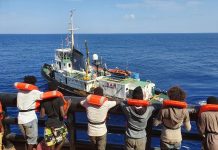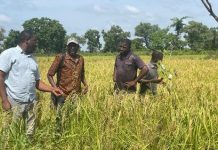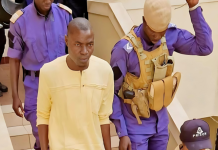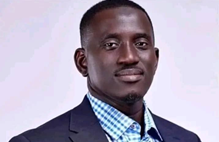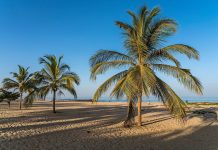By Rohey Jadama
Mr. Bakary Darboe, a chief Inspector attached to the Major crime unit at police headquarters, yesterday continued his testimony as the first prosecution witness (PW1) in the ongoing trial involving Mrs. Sira Wally Ndow Njai and 8 other officials in the Gambia National Petroleum Company (GNPC) case.
as the first prosecution witness (PW1) in the ongoing trial involving Mrs. Sira Wally Ndow Njai and 8 other officials in the Gambia National Petroleum Company (GNPC) case.
Testifying before Justice O. Otaba of the special criminal division of the Banjul high court, PW1 said they received a contract document from GNPC. He said the contract was signed between GNPC and March petroleum.
He adduced that the tabulation explains the losses incurred during the implementation of the contract. When asked by Hadi Saleh Barkun , the Director of Public Prosecution (DPP) what other document he recovered during their investigation, the witness responded that the above mentioned documents are the two main documents that they recovered.
While responding to questions under cross-examination from Barrister Sheriff Marie Tambedou, defence counsel for Mrs. Ndow-Njai, the witness responded that he has served the police force for 25 years, 8 months.
He further told the court that there was an investigation team and that he was part of the said team but that he was not the head of the team. He said he only took the cautionary statement of the 1st accused and that he was not the only one taking statements.
When asked whether all the members of the investigative team are police officers, the witness responded in the negative, adding that the team comprised Bakary Darboe (Himself), Baba Danso, Baboucarr Ndure and Yankuba Kinteh.
When asked how many statements he obtained from Mrs. Ndow Njai, the witness responded that he only took one statement from her. When asked again who obtained the other statements from Mrs. Ndow Njai, the witness responded that he doesn’t know.
When asked who has custody of the statements obtained from the 1st accused? The witness responded that as far as he knows, the statements are in the custody of the state prosecutor.
“You will agree with me that two other cautionary statements were obtained from the 1st accused?” asked counsel. “That is a possibility, the one I obtained is an additional one,” answered the witness.
Counsel asked, “I’m putting it to you that two cautionary statements dated 21st and 28th June ,2016 were obtained from the 1st accused ?” The witness answered, “I’m not denying it is possible.”
When asked whether he can produce the statements, he responded in the negative adding that the said statements are not in his possession.
At this juncture, the witness was given a document to look at. Counsel asked, “Take a look at exhibit A. You can see paragraphs and if you turn you will see 2, 3 and 4 is that correct?” He answered, “Yes.”
Counsel stated, “These paragraphs are an answer to questions is that correct?” He answered, “Yes”.
Counsel asked, “You recorded the answers, why did you not record the questions?” The witness answered, “The statement was recorded by the first accused person herself.”
Counsel noted, “You will agree with me that what the first accused person recorded are answers she was giving you?” He answered, “Exactly.”
Counsel noted, “Where is the questionnaire you gave to the 1st accused to answer?” However, before the witness could answer, the DPP interjected by objecting to this question, arguing that the witness never said there was a questionnaire.
Responding to the objection of the DPP, defence counsel Tambedou urged the court to overrule the DPP’s objection and allow the witness to answer.
“The DPP cannot tell me nor does the defence counsels what questions to ask. We have laid the foundation that the answers to the questions in the paragraphs are the only ones recorded. The issue of whether a questionnaire exists does not arise because the evidence of the witness indicates that it exists. The witness is competent enough to answer. It’s not the DPP to hint the witness what to say,” submitted Lawyer Tambedou.
In his ruling, Justice Otaba overruled the objection of the DPP and the witness was ordered to answer.
Answering the question, the witness said the questionnaire must have been in the case file.
When asked whether he can produce the said questionnaire in court, DPP objected and argued that the witness can only produce something within his powers. He referred the court to section 220 of the evidence act to support his argument.
However, Lawyer Tambedou said section 220 is not relevant to the case because the said section refers to a witness who is summoned and that is not the situation in this case so it does not apply. He urged the court to overrule the DPP’s objection and allow the witness to answer.
In his ruling, Justice Otaba said the question is a very simple question which the witness can answer. He overruled the DPP’s objection and ordered the witness to answer the question.
Answering the question, the witness responded that he cannot produce the said the said document because it is not in his possession and that it is sent to the Attorney General’s Chambers.
When asked when did the 1st,2nd and 3rd investigation started in the case, the witness said he can’t remember the exact date and month of the 1st and 2nd investigation, but he was quick to add that he think is late July and early August. He, however, said that he doesn’t know of any 3rd investigation in the case.
“Where is the 1st investigation report in this case?” enquired Lawyer Tambedou. “I cannot tell because I was not part of it,” responded the witness. Counsel added, “Which investigative team are you part of?” “The 2nd investigative team.” Counsel added, “Where is the report?” The witness said, “It was sent to AG Chambers.”
Counsel asked, “Who wrote the 2nd investigative report?” He answered, “It was written by the panelist.” The counsel said, “Is it the 2nd report that alleges the loss of $12million?” The witness answered, “Our report didn’t allege the loss of $12million.” Counsel asked, “Is it your report that alleges the loss of $9million?” He answered, “No Sir”. The counsel asked, “How much loss did your report allege is suffered by the state?” He answered, “If my memory can serve me it was over $7million dollars.”
Counsel noted, “The tabulation that you referred to in your testimony do you have it?” Witness answered, “Yes my lord”. The witness asked, “Is it the tabulation that you referred to, to arrive at this conclusion?” He answered, “Yes.” Counsel said, “Now take a look at this document, do you recognize it?” He answered, “Yes.” Counsel asked, “Did your investigation team rely on this document during your investigation?” He answered, “Yes, my lord”.
At this juncture, Lawyer Tambedou applied to tender the said document as a defence exhibit.
However, the DPP objected to the tendering of the said document.
Responding to the objection of the DPP, Barrister Tambedou urged the court to overrule the objection because the witness has identified the document and further told the court that it was relied upon during their investigation.
However, before the presiding judge could deliver his ruling on the objection, the DPP withdrew his objection and the document was thus admitted and marked as exhibit G.
The case continues today, 3 November, 2016 from 12noon to 1pm for continuation of cross-examination of PW1.

